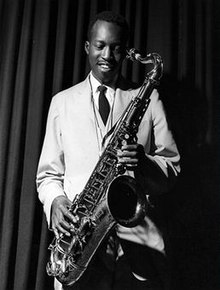Hank Mobley
| Hank Mobley | |
|---|---|
 Mobley c. 1956 | |
| Background information | |
| Birth name | Henry Mobley |
| Born | (1930-07-07)July 7, 1930 Eastman, Georgia, U.S. |
| Died | May 30, 1986(1986-05-30) (aged 55) Philadelphia, Pennsylvania |
| Genres | Jazz, hard bop, soul jazz |
| Occupation(s) | Musician, composer |
| Instruments | Tenor saxophone |
| Years active | 1949–1986 |
| Labels | Blue Note, Prestige, Savoy |
Henry "Hank" Mobley (July 7, 1930 – May 30, 1986) was an American hard bop and soul jazz tenor saxophonist and composer. Mobley was described by Leonard Feather as the "middleweight champion of the tenor saxophone", a metaphor used to describe his tone, that was neither as aggressive as John Coltrane nor as mellow as Stan Getz, and his style that was laid-back, subtle and melodic, especially in contrast with players like Sonny Rollins and Coltrane. The critic Stacia Proefrock claimed he is "one of the most underrated musicians of the bop era."[1]
Contents
1 Biography
1.1 Early life and education
1.2 Career
1.3 Retirement
2 Discography
3 Notes
4 References
5 External links
Biography
Early life and education
Mobley was born in Eastman, Georgia, but was raised in Elizabeth, New Jersey, near Newark.[2] When he was 16, an illness kept him in the house for several months. His grandmother thought of buying a saxophone to help him occupy his time, and it was then that Mobley began to play. He tried to enter a music school in Newark, but could not, since he was not a resident, so he kept studying through books at home.
Career
At 19, he started to play with local bands and, months later, worked for the first time with musicians like Dizzy Gillespie and Max Roach.[3] He took part in one of the earliest hard bop sessions, alongside Art Blakey, Horace Silver, Doug Watkins and trumpeter Kenny Dorham. The results of these sessions were released as Horace Silver and the Jazz Messengers. They contrasted with the classical inclinations of cool jazz, with Mobley's rich lyricism being bluesier, alongside the funky approach of Silver. When The Jazz Messengers split in 1956, Mobley continued on with pianist Silver for a short time, although he did work again with Blakey some years later, when the drummer appeared on Mobley's albums in the early 1960s.
In 1956, Mobley recorded the album Mobley's Message with Jackie McLean and Donald Byrd. AllMusic gave the album 4 stars out of 5, and users gave the album 4.5 out of 5 stars.[4]
During the 1960s, he worked chiefly as a leader, recording over 20 albums for Blue Note Records between 1955 and 1970, including Soul Station (1960), generally considered to be his finest recording,[5] and Roll Call (1960). He performed with many of the other important hard bop players, such as Grant Green, Freddie Hubbard, Sonny Clark, Wynton Kelly and Philly Joe Jones, and formed a particularly productive partnership with trumpeter Lee Morgan. Mobley is widely recognized as one of the great composers of originals in the hard bop era, with interesting chord changes and room for soloists to stretch out.
Mobley spent a brief time in 1961 with Miles Davis, during the trumpeter's search for a replacement for John Coltrane. He is heard on the album Someday My Prince Will Come (alongside Coltrane, who returned for the recording of two tracks), and several live recordings (In Person: Live at the Blackhawk and At Carnegie Hall). Though considered by some as not having the improvisational fire of Coltrane, Mobley was known for his melodic playing.
Retirement
Mobley was forced to retire in the mid-1970s, due to lung problems. He worked two engagements at the Angry Squire in New York City November 22 and 23, 1985, and January 11, 1986, in a quartet with Duke Jordan and guest singer Lodi Carr a few months before his death from pneumonia in 1986.[6]
Discography
Notes
^ Proefrock, Stacia. "Hank Mobley: Soul Station". AllMusic. All Media Network. Retrieved 14 January 2015..mw-parser-output cite.citation{font-style:inherit}.mw-parser-output q{quotes:"""""""'""'"}.mw-parser-output code.cs1-code{color:inherit;background:inherit;border:inherit;padding:inherit}.mw-parser-output .cs1-lock-free a{background:url("//upload.wikimedia.org/wikipedia/commons/thumb/6/65/Lock-green.svg/9px-Lock-green.svg.png")no-repeat;background-position:right .1em center}.mw-parser-output .cs1-lock-limited a,.mw-parser-output .cs1-lock-registration a{background:url("//upload.wikimedia.org/wikipedia/commons/thumb/d/d6/Lock-gray-alt-2.svg/9px-Lock-gray-alt-2.svg.png")no-repeat;background-position:right .1em center}.mw-parser-output .cs1-lock-subscription a{background:url("//upload.wikimedia.org/wikipedia/commons/thumb/a/aa/Lock-red-alt-2.svg/9px-Lock-red-alt-2.svg.png")no-repeat;background-position:right .1em center}.mw-parser-output .cs1-subscription,.mw-parser-output .cs1-registration{color:#555}.mw-parser-output .cs1-subscription span,.mw-parser-output .cs1-registration span{border-bottom:1px dotted;cursor:help}.mw-parser-output .cs1-hidden-error{display:none;font-size:100%}.mw-parser-output .cs1-visible-error{font-size:100%}.mw-parser-output .cs1-subscription,.mw-parser-output .cs1-registration,.mw-parser-output .cs1-format{font-size:95%}.mw-parser-output .cs1-kern-left,.mw-parser-output .cs1-kern-wl-left{padding-left:0.2em}.mw-parser-output .cs1-kern-right,.mw-parser-output .cs1-kern-wl-right{padding-right:0.2em}
^ Steve Huey, "Artist Biography", AllMusic.
^ Hank Mobley Quartet (Liner notes). Blue Note Records. 1955. BLP 5066.
^ "Mobley's Message - Hank Mobley | Songs, Reviews, Credits | AllMusic". AllMusic. Retrieved 2017-12-07.
^ Blumenthal, Bob (1999) [1960]. "A NEW LOOK AT SOUL STATION". Soul Station (The Rudy Van Gelder Edition) (Media notes). Hank Mobley. Blue Note Records/Capitol Records.
^ Nelson, Nels (4 June 1986). "Hank Mobley, International Jazz Figure". The Philadelphia Inquirer.
References
Ansell, Derek (2008). Workout: The Music of Hank Mobley. London: Northway Publications. ISBN 978-0-9550908-8-2.
External links
Hank Mobley discography at Discogs
Hank Mobley at Find a Grave
- Steve Huey, "Artist Biography", AllMusic.